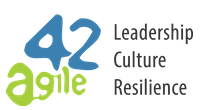Organizational Culture Breeds Agility
Embarking on a journey towards agility often requires a shift in organizational culture. Agility is more than just a set of rules and practices. It calls for a mindset attuned to agile values and principles. Failure to extend this change to organizational culture can end the agile transition before it even begins.
Every organization has its own unique culture – a particular way of how things are done within the organization. It is articulated by how people in the organization behave and interact with one another, which in turn depends on traditions, beliefs, habits and expectations. It evolves as people inside the organization grow, mature and their relationships develop, or when new people join the organization with fresh new ideas. Who we are has as much impact on organizational culture as how we behave and the large view or picture of a culture may often seem complex, intangible and abstract enough to defy definition.
How can we understand organizational culture?
At agile42, we aim to gain insight to an organization’s culture by using the Organizational Scan™ (OrgScan). We developed the tool by incorporating decades worth of research, experience and technology. With OrgScan we try to capture people’s interactions, decision-making approaches and emotional responses and in doing so create a picture of the organization’s culture.

OrgScan collects real-time data about decisions that people are making within the organization and how these decisions affect people. Capturing this data in the form of micro-narratives provides both qualitative and quantitative information through data points and their position, which allows us to recognize patterns and shifts. It makes an organization’s culture, leadership and employee engagement transparent and provides insight into improvement opportunities.
One of the most interesting results of an OrgScan is how different factors of decision-making influence how decisions are perceived. These factors can include decision-making speed, individual or team autonomy, clarity of communication and the perception of the appropriateness of leadership behavior. Analyzing interdependencies between these factors can provide insights into an organization’s resilience, its capability to respond to internal and external challenges.
OrgScan is based on Dave Snowden’s Cynefin framework, The Cynefin Company’s SenseMaker® technology, Linda Doyle’s Vector Theory of Change as well as the renowned Competing Values Framework as described in the book Diagnosing and Changing Organizational Culture by Kim Cameron and Robert Quinn. Due to its significance to this case study, we would like to elaborate more on the Competing Values Framework.
What is the Competing Values Framework?
The Competing Values Framework is an established model to describe organizational culture. It takes into consideration organizational behaviors, approaches, beliefs and values.
As the name suggests, it looks at competing or conflicting factors that can create tensions within organizational culture along two dimensions.
- The first dimension, flexibility versus stability, describes the degree to which the culture strives for diversification and individuality compared to aiming for standardization and control.
- The second dimension, internal versus external orientation, describes whether the organization focuses more on processes, roles and responsibilities or more on market demands, customer needs and competition.
These two dimensions form four quadrants which represent a distinct culture type with the following characteristics:
- Leadership behavior is the dominant behavior of the leaders within a group, which impacts group organization and emerging culture.
- Orientation to work is the way in which work is approached.
- Theory of effectiveness is the underlying theory leading to success within an organization. This is often propagated through stories of success and failure.
- Value drivers are the internalized values and motivators amongst people working in a specific group or context.
Four types of organizational culture
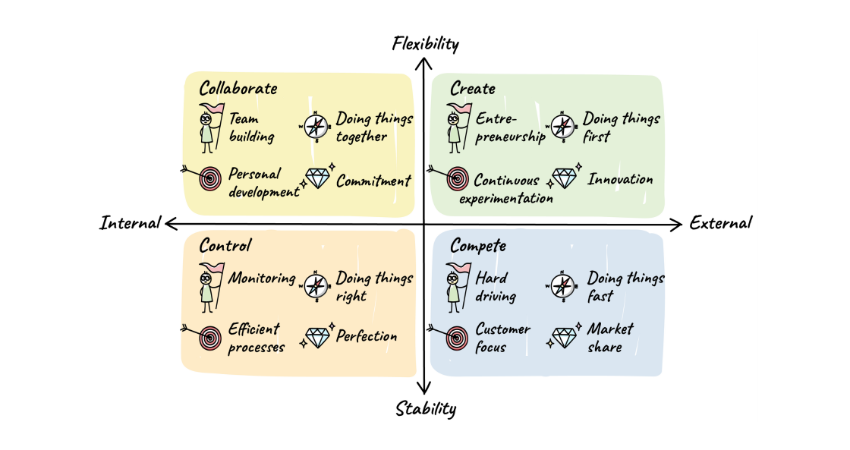
No organizational culture is present in only one of the four quadrants. Any culture has characteristics of all four culture types. It should be well balanced while being suited for the organizational purpose.
The Collaborate culture is internally focused and strives for diversification. People want to develop things together and sustainably. They value teamwork and nurture relationships, and their commitment to developing themselves and others holds them together. Favoring consensus means that decision-making can take longer. We would expect this type of culture in universities, local communities or social services.
The Control culture is defined by a strong internal focus and a need for standardization. People strive for perfection and focus on assessing and measuring performance, controlling processes, finding ways to improve efficiency and enhancing quality. Procedures govern what people do. This culture does not take risks because failure is not an option which can hinder innovation. We would expect this type of culture in an aircraft’s cockpit, an emergency room or administrative offices.
The Create culture is also geared towards diversification but, in contrast to Collaborate, it has a strong external focus. These are entrepreneurs, artists, visionaries and disruptors. People in an organization are held together by their shared vision. They experiment and try out new ideas, speculate about the future and continuously try to come up with innovative solutions. They are natural risk-takers and will always see an opportunity in a problem. However, they typically lack processes and routines. This type of culture is common in early-stage startup companies and the tech industry.
The Compete culture combines an external focus and a drive for standardization. People within a competitive culture are very much like athletes: hard drivers, focused on goal achievement and on short term gains. They are more concerned about winning competitions or closing deals than the sustainability of the future which is why they appreciate quick responses and decisiveness. They strive to increase profit or market share and may therefore fail to focus enough on people’s development and well-being. Typically, we would expect this type of culture in a sales organization or advertising agencies.
How do we get the culture we need?
Unfortunately, we cannot design or plan an organizational culture because it is the product of multiple complex interactions between people as well as the interdependencies of rituals, processes and policies established by the organization.

Due to its complex nature, an iterative and incremental approach is the only way to influence organizational culture. In order to nudge the culture towards greater coherence, the best place to start is with leadership behavior. Changing how we behave as leaders will naturally influence the way work is carried out. If those new experiences turn out to be successful, people will start sharing new stories of success with one another. Once enough people have experienced success adopting a new approach and consequently developed more effective rituals to carry out their work, then eventually the value system will shift and include new values, altering the value drivers of the organizational culture.
Agility is a set of values and principles, or in other words a belief system or mindset. This is why the success of an agile transition depends primarily on the organization’s culture and its willingness to collaborate closely with customers and respond to change flexibly. The complex process of shifting towards a more agile culture is easier for some to manage than others. OrgScan provides both a differentiated perspective of the starting point and facilitates the discovery of the direction for change. It enables continuous feedback by integrating multiple narratives and leaving no voices unheard.
Benefits of OrgScan
Bringing about change in an organization is a difficult process and, unfortunately, often fails. Change initiatives often disregard the complex nature of organizational culture. Rather than following a predefined implementation blueprint, OrgScan is used to envision and enact change in harmony with the existing culture, moving toward the next adjacent possibility and enabling lasting improvement.
The initial assessment provides a mapping of the current cultural profile and connections from the perspective of those within the organization. From there, the goal is to encourage a shift in culture, develop the right leadership capabilities and promote appropriate decision-making through safe-to-fail experiments in order for new patterns and behaviors to emerge that reflect the desired cultural fit for the organization’s purpose. Continuing to use OrgScan to collect narratives and their interpretations provides a continuous assessment of the organization and immediate feedback on developments and changes throughout the organization.
Organizational culture is a complex system at a company’s core. It is both flexible and adaptive, yet rather robust towards large sweeping changes. Tools such as OrgScan serve to highlight the nature of an organization’s culture and detect and monitor avenues through which to encourage and facilitate shifts that align it with developmental goals.
Case Study
Our case study demonstrates how Organizational Scan™ contextualizes organizational culture, enabling measures that can shift it towards desirable outcomes within the culture’s framework. Our client’s goal was to transition to a more agile way of working in order to shorten time to market and fuel innovation.
Seventy-nine members of the product development organization participated in the OrgScan between August and November 2021. OrgScan provided data and insights to establish a baseline and gain a clearer understanding of the organization’s culture, revealing points of friction to become a basis for further investigation and intervention. agile42 analyzed the data thoroughly and created a comprehensive report that includes key facts, hypotheses and improvement opportunities related to the organization’s goal to strengthen their agility. A few of our findings are summarized below:
Leadership behavior used during the decision-making process
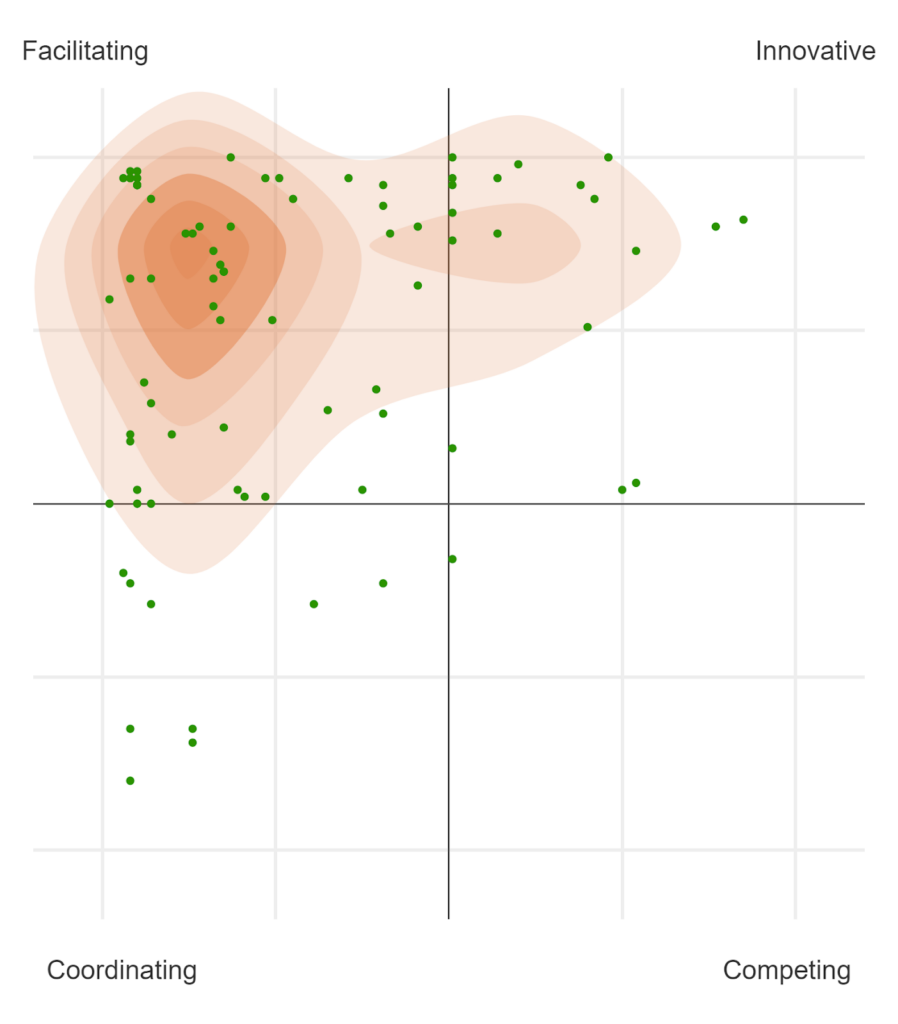
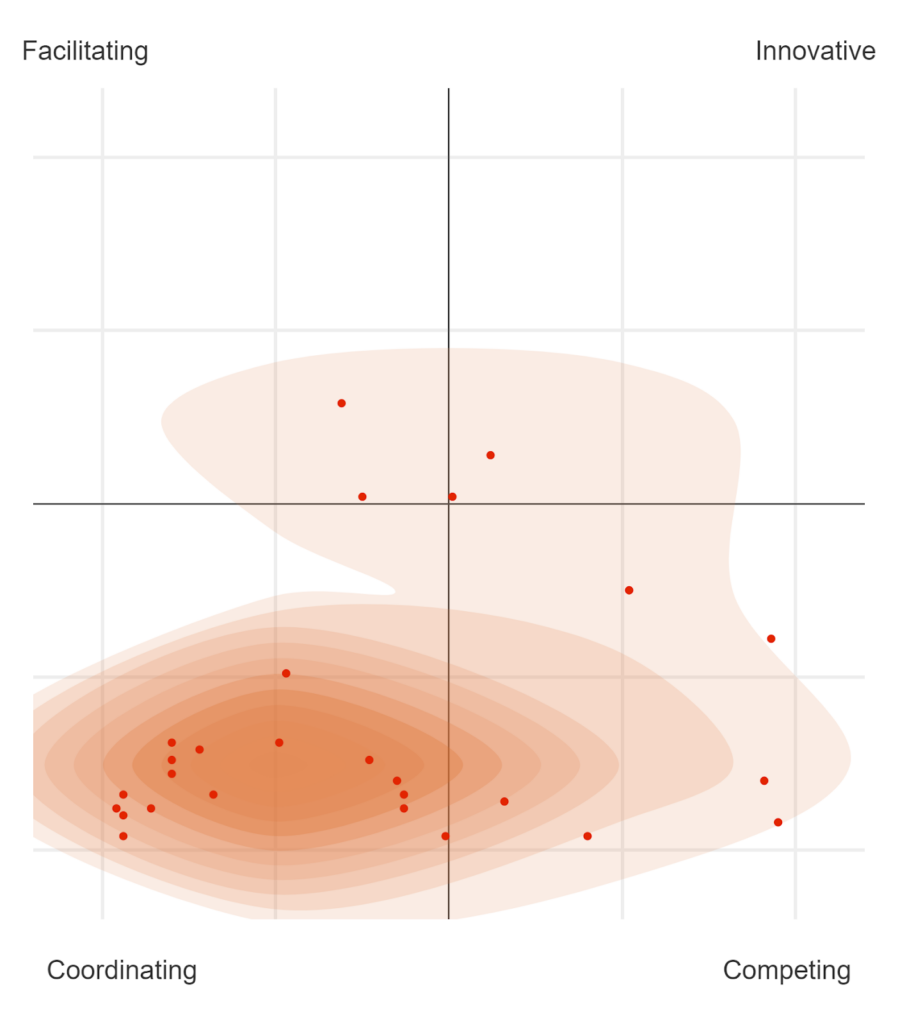
The data shows that the organizational culture is internally focussed. Leadership behavior has a big impact on how decisions are perceived emotionally, with the majority of captured decisions being perceived positively due to a heavier emphasis on collaborative leadership behavior. The data reveals that people generally want to be involved in decisions, even when those decisions are difficult. When managers step in and move towards a more controlling approach, this tends to be perceived negatively since it leads to excluding teams from important decisions.
Reviewing the data, one of the product department’s leaders summarizes:
“Even if the data confirmed many of our gut feelings, understanding the images was an important and crucial step. It is incorrect to assume that decisions made by management are always bad, but we do understand that there are some topics that don’t have to be escalated or should be decided with wider participation. Fortunately, we have a good understanding of which topics these are. This, and the increased understanding of what is appreciated from a cultural point of view, helps us to facilitate important topics in a better, more informed way.”
Time taken for making decisions
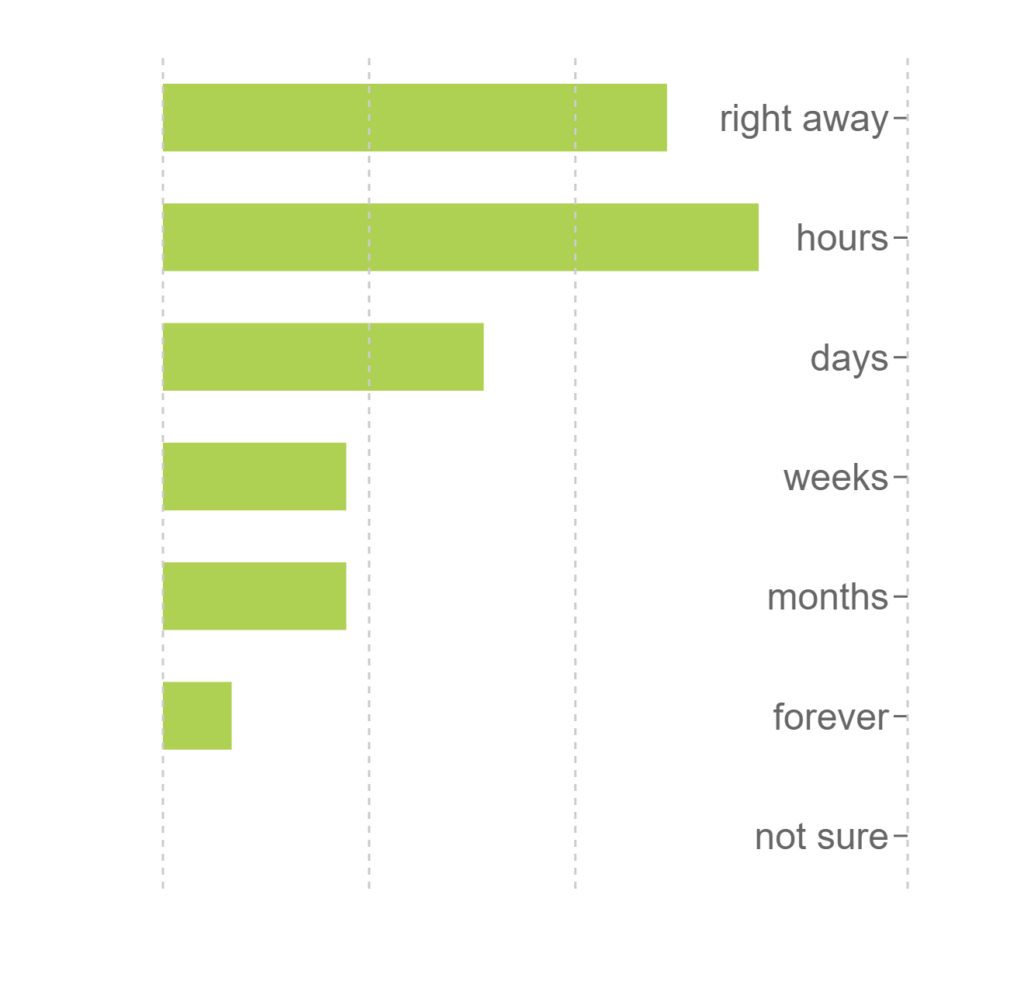
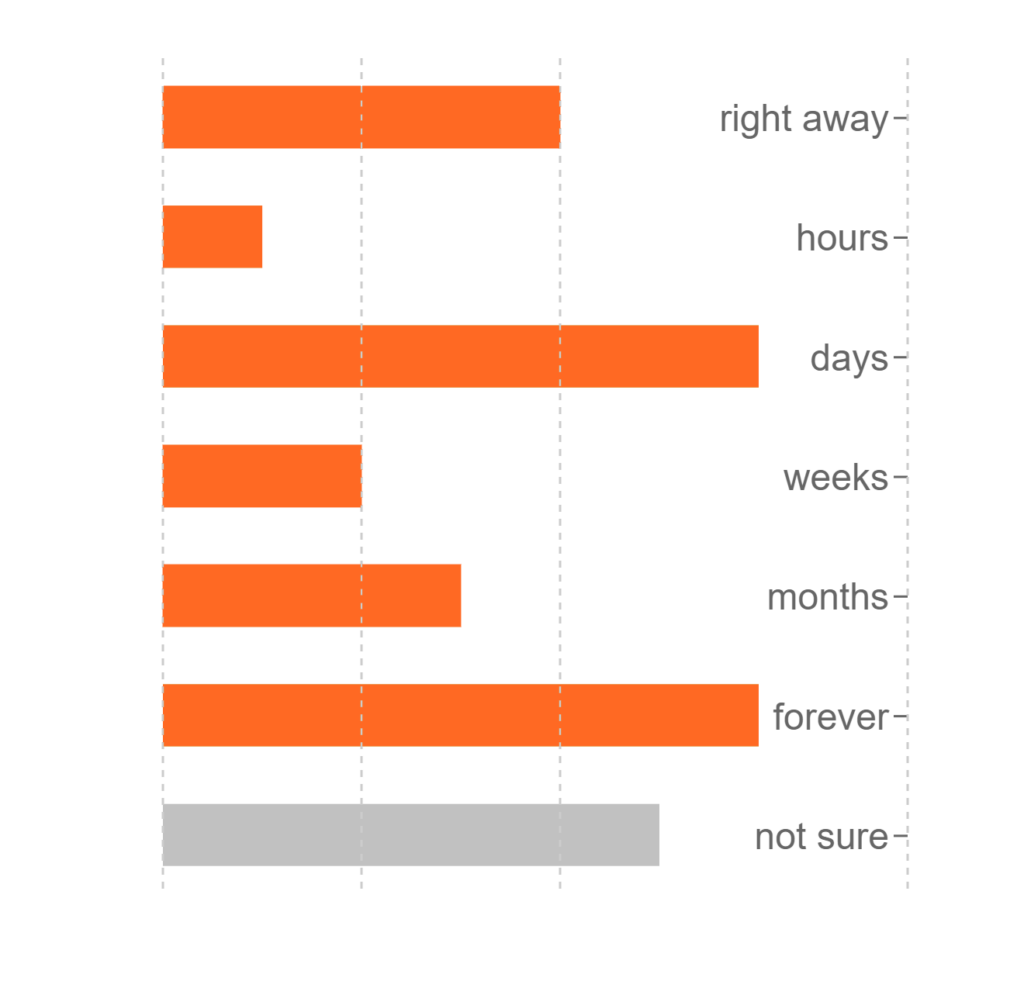
Left in green are decisions that were captured and interpreted in a positive light by the participants, while those perceived negatively are on the right in orange. Unsurprisingly, a fast turnaround on decisions was perceived more positively and the organization proved itself competent in this regard, providing fertile ground for agility and innovation.
Leadership behavior vs. time taken
Based on prior findings, the following graph hones in on the decisions made right away and those which took forever:

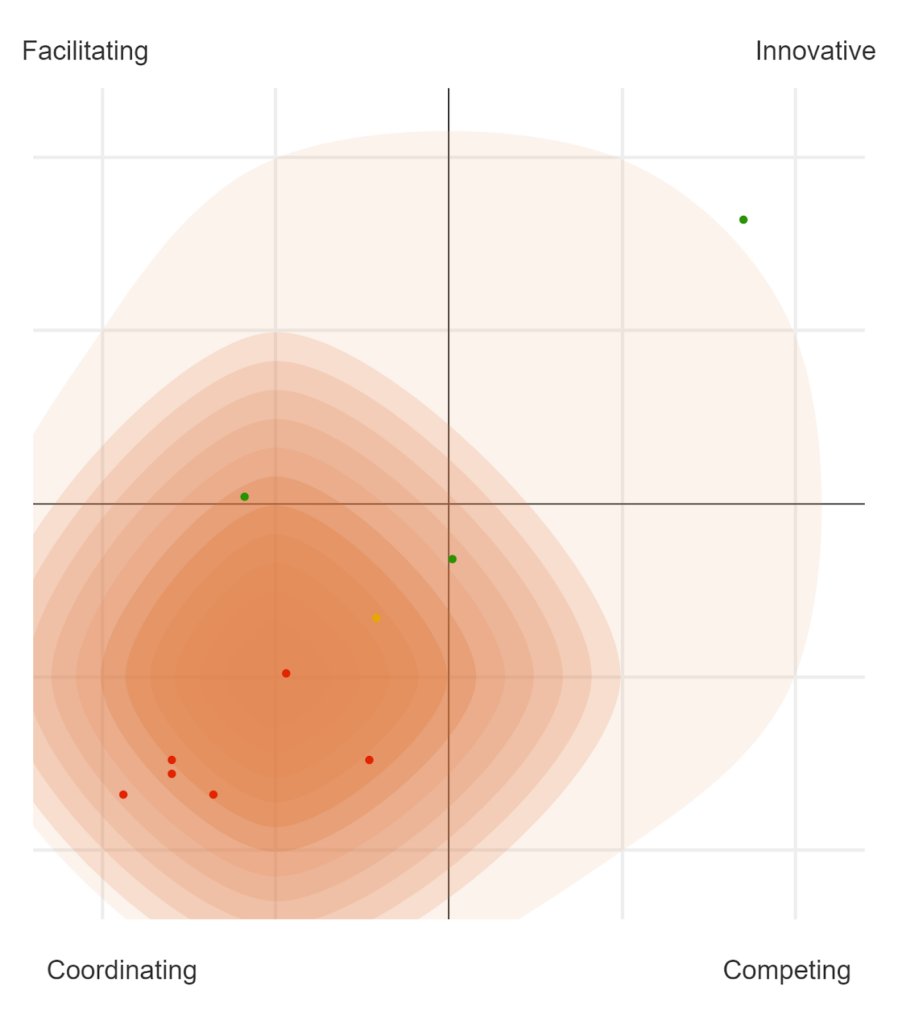
Collaborative leadership behavior seems to enable rapid decision-making as the first graph shows, while coordinating leadership behavior tends to cause delays. These delays might be the reason people get frustrated. The dominant way of making decisions is collaborative consensus-building, even in critical or difficult situations. People inside the organization generally want to be involved in decisions.
OrgScan data provided a clear preference for collaborative leadership behavior which enabled involvement in the process and a faster turnaround.
Experiment: Designing Career Paths
Based on data gained from OrgScan, interventions and experiments were designed to establish interactions using approaches that would better fit the desired organizational culture. Reflection and feedback on the outcomes of these interventions allowed for further refinement. As explained above, teams appreciate working in a very collaborative manner. Additionally, creative approaches and risk-tolerant approaches to making decisions were becoming increasingly popular, showing a desired shift in culture.
Contrastingly, the organizational culture remains partially anchored in the Control type, which is not always perceived negatively. A closer examination of provided data and narratives gives a clearer picture of when centralized decision-making is appreciated:
- Topics escalated from teams falling under management’s purview are welcomed.
- Management claiming critical decisions for themselves without the team’s involvement generally is perceived negatively.
Efforts by management to facilitate critical decision-making were not received the way they had hoped, causing friction between managers trying to enable their teams and teams feeling excluded from difficult decisions. Teams wanted to be involved, even in issues that ended up escalated to management.
The friction between Collaborate and Control culture types was regarded as the first port of call for change. Through targeted experiments, participants were enabled to move outside of their personal comfort zone and towards a joint starting point for further organizational development.
Based on established narratives and the resulting cultural profile, an area was identified where one-sided solutions would receive an immediate veto from differently oriented parties within the organization: defining roles and career paths for Scrum Masters.
Defining experiment parameters
Designing a career path for a new role provides both a sense of direction and potential for development. The result will impact those affected by it tremendously. However, while the reasoning behind such a step seems clear, the methods chosen could vary greatly when approached from different perspectives and cultural types. Bridging that gap was one of the main challenges during the experiments.

The Scrum Masters’ primary focus was to ensure their career paths were developed in collaboration with the organization’s leadership, while senior management felt it essential that new career paths modeled themselves on existing structures within the organization and remained comparable. Both sides differed both in their priorities and perspectives- Scrum Masters being primarily concerned with collaboration, while senior management wanted to remain within established guidelines.
In an effort to satisfy both sides’ needs, an experiment was designed in which members of senior management and Scrum Masters worked together to identify key parameters of the Scrum Master career path. In order to facilitate swift results, senior management and Scrum Masters agreed to each select three representatives with decision-making power. During four sessions, these representatives were paired up randomly to work on the following questions:
- What are Scrum Masters’ responsibilities?
- How to assess seniority within specific areas of expertise?
- Are requirements for senior positions adequately distributed and comparable across functions?
- How can we map the seniority of a Scrum Master to existing career paths and their understanding of seniority?
Conducting the experiment
Throughout these sessions it proved beneficial to work in iterations to focus the group and aid in tackling an otherwise broad and complex subject in smaller increments. Existing structures and models served to orientate efforts in defining the role and breadth of areas of expertise of a Scrum Master and created common ground among participants.
Taking the cultural needs of the organization and expectations of its people into account during the decision-making process greatly improved the quality of their results and their acceptance of the process. Participants expressed satisfaction with the outcome of the experiment, the way it was executed and the appreciation for each other.
Using the insights from OrgScan to conduct an experiment helped with making better decisions, communicating those decisions effectively and, most importantly, defining the leadership behavior most appropriate in this context.
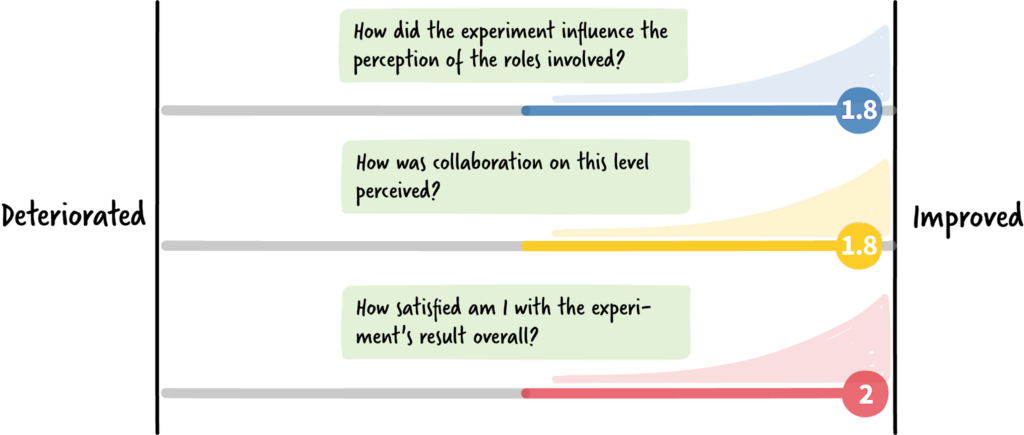
Final thoughts
The challenge was to find a way to bridge the gap between cultures, without initially having much common ground to work from due to a difference in perspectives and approaches aimed at overall improvement. With OrgScan providing data to identify the nature and extent of those differing perspectives, change agents were able to create and run experiments that fostered mutual understanding, broadening viewpoints into a shared baseline from which to continue together. Formerly disparate parties were able to begin redefining culture on their own terms and, using OrgScan, will be able to monitor continuous development and maintain these broadened perspectives.
The product department leader concludes:
“Change agents are receptive to how certain decisions or behaviors affect an organization’s atmosphere. Senior leadership values objective data over subjective impressions. OrgScan data allowed us to validate how decision-making was perceived within the organization and gave voice and factual backing to our impressions. This made it much more tangible for senior management and led to the discussion around agility shifting from a structural debate to a cultural exchange.”
